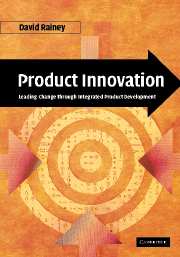Book contents
- Frontmatter
- Contents
- Preface
- Acknowledgements
- Part I Product innovation and strategic logic
- Part II Establishing the foundation: the conceptual level
- Part III Methods and techniques for analysis and decision making
- Part IV The operational level and concluding remarks
- 11 Design and Development (Phase 4)
- 12 Validation (Phase 5)
- 13 Pre-commercialization (Phase 6) and the launch
- 14 Concluding remarks and insights about product innovation in the twenty-first century
- Glossary
- References
- Select bibliography
- Index
12 - Validation (Phase 5)
Published online by Cambridge University Press: 10 August 2009
- Frontmatter
- Contents
- Preface
- Acknowledgements
- Part I Product innovation and strategic logic
- Part II Establishing the foundation: the conceptual level
- Part III Methods and techniques for analysis and decision making
- Part IV The operational level and concluding remarks
- 11 Design and Development (Phase 4)
- 12 Validation (Phase 5)
- 13 Pre-commercialization (Phase 6) and the launch
- 14 Concluding remarks and insights about product innovation in the twenty-first century
- Glossary
- References
- Select bibliography
- Index
Summary
Introduction
Validation is an integral part of the new-product development (NPD) process. It is embedded within the NPD process and serves as a mechanism to verify that the decisions are appropriate and in line with objectives and expectations. The reviews at the end of each phase and the Validation Phase itself are the main methods for improving the probability that positive outcomes will be achieved.
During the Validation Phase, decisions made during design and development are evaluated and tested to ensure that the new product meets customer and stakeholder expectations. The validation process includes examining the most significant elements of the NPD program, proving that the product meets specifications, and reducing defects and burdens.
The reduction of uncertainties during the Validation Phase provides management and practitioners with the confidence that critical success factors have been duly considered and that barriers to implementation have been mitigated. The Validation Phase focuses on major risk-reduction methods that require time, effort, and money to complete. Such methods are usually necessary for obtaining management's commitment to fund the Pre-commercialization Phase and Launch. The Validation Phase provides evidence that the potential of the new product is worth the investment and that there are no undue concerns about spending the money to launch the product. This is particularly appropriate where most of the investment is incurred just before commercialization, or if there are significant strategic, market, technical, or financial risks and uncertainties. For example, non-durable consumer products require a significant expenditure in advertising during the Pre-commercialization Phase.
- Type
- Chapter
- Information
- Product InnovationLeading Change through Integrated Product Development, pp. 514 - 547Publisher: Cambridge University PressPrint publication year: 2005



